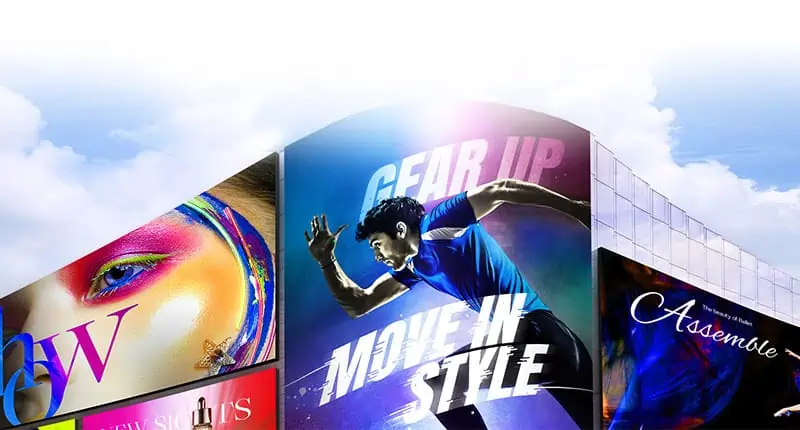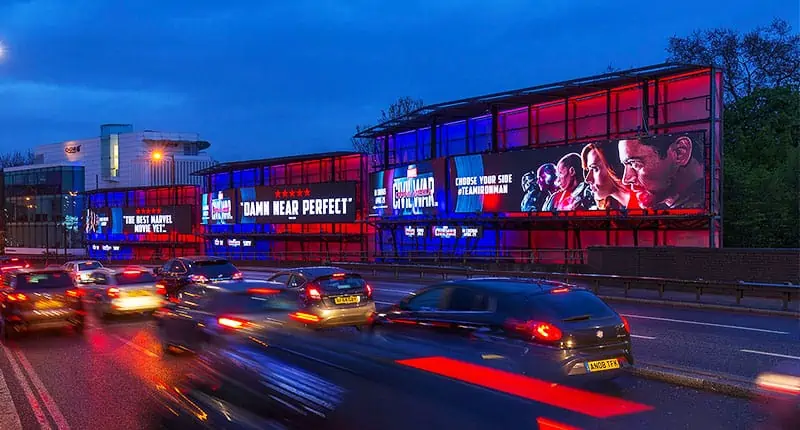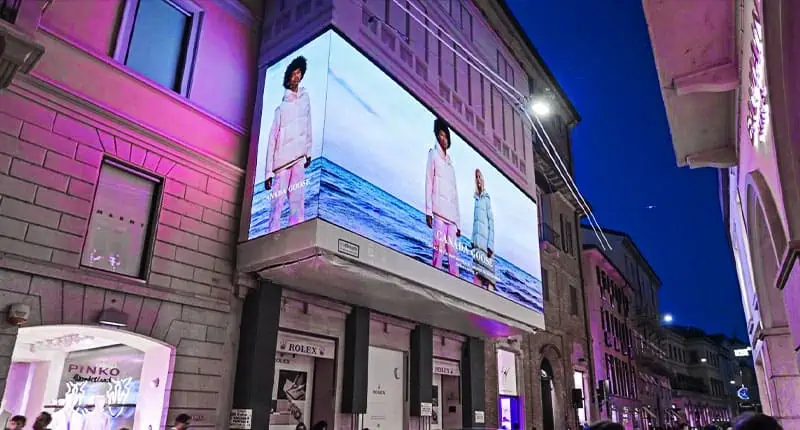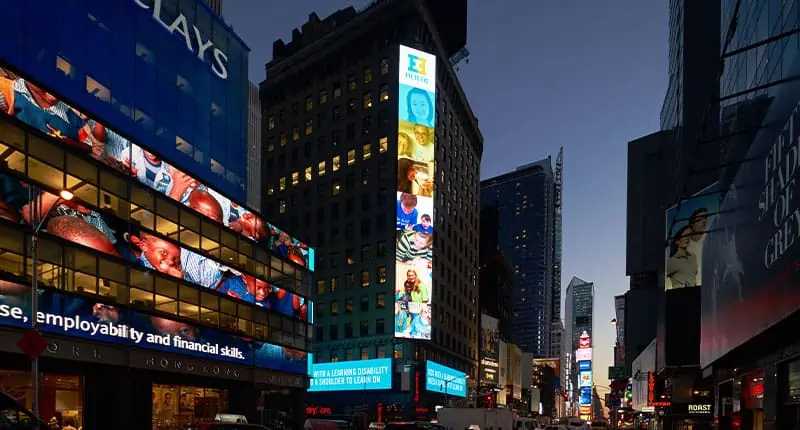There’s no better way to draw attention to your brand or company than with an outdoor LED display. With crystal-clear pictures, bright colors and vivid displays, today’s video screens are a far cry from traditional printed materials of the past.
While LED indoor displays have been used widely in stores, malls, schools, hospitals, and restaurants, business owners are also realizing outdoor displays can be used for information delivery, traffic driving, eyeball attracting, and revenue increasing. Business owners and advertisers are gaining new opportunities to raise brand awareness with functional, affordable and effective outdoor displays.
For those who want to take advantage of this new led technology in outside traffic places, here are some important crucial pieces of information you should know to ensure you’re building the successful outdoor led display screen.
So, What is an outdoor LED screen?
The term outdoor LED screen is typically referring to a large outdoor video wall that utilizes LED technology. In contrast to a single panel display such as an LED TV or monitor, video walls are constructed by linking multiple panels together, allowing for large sizes and custom shapes.
These panels utilize a very high brightness for outdoor visibility and durable hardware for resistance to nature’s elements. Large sizes accommodate far away viewing distances by many people at once. Applications include digital billboards, monument signs, stadium, rental, outdoor LED signage & more.
Technical Considerations
1. Visual quality
Outdoor signage is meant to draw the attention of passersby and communicate a message about your brand. The vividness of the image has a significant impact on how that message is received. Your outdoor LED signage should be bright and vibrant, and it should display colors accurately. Skin tones that look washed out, for example, will draw negative attention, so check the LED supplier spec sheet to be sure the display shows true-to-life color.
Another key spec to consider is the pixel pitch or the space between the RGB pixels. It’s important you choose a vendor that will specify the right pixel pitch for the viewing distance. Overspecifying the pitch may cost more, but if the pixel pitch is too large, it may lower the visual quality.
2. Environmental ruggedness
Depending on where your outdoor sign is located, you may need to consider how it operates in hot or cold temperatures, as well as in rain, snow, wind, dust, or humidity. In these cases, the design of your screen and its enclosure is critical to the continuous operation of the LEDs and their longevity.
In terms of environmental factors, your first consideration should be removing heat from the LED elements and driving electronics. Ask any vendor about their thermal management solution and its ability to maintain LED temperatures within a narrow range in the environmental conditions you anticipate. To protect your signage from the elements, check that the enclosure design meets specifications for resistance to water, dust, humidity, etc. — whatever concerns apply to your location.
When water seeps through the LED enclosure, your display can be damaged – or worse – fail completely. In order to reduce the risk of brain damage, you must look for displays that have a high IP rating to protect against moisture and solid objects.
In addition, when the outdoor led display stand close to the sea, make sure the materials are against salt corrosion.
3. Internal Temperature Regulation
Outdoor LED screens require an optimal internal temperature to function properly. The working of LED displays will generate a certain amount of heat. If the ambient temperature is too high and the cooling is not effective, the integrated circuit may not work normally or even be burnt down, thus making the display unable to work.
To protect your screen against this risk, you must Install an axial flow fan above the back of the display to discharge heat to keep the internal temperature of displays between -10℃ and 40℃. If you’re in an extremely hot area, your outdoor screen should have an HVAC system installed that can regulate its internal temperature.
4. Brightness
In any case, your outdoor display should be highly visible. High brightness with high contrast can be crucial aspects to capture the attention of the passerby, stimulate their interests, and leave an unforgettable brand impression. Video wall brightness is measured in nits. The higher the nit rating, the higher the brightness. Outdoor panels require a minimum brightness rating of 5,000 nits to allow for visibility under direct sunlight.
5. Lightning protection
The installation of lightning arresters on displays and buildings. Keep the main body and the shell of displays well-grounded, with the grounding resistance less than 3 ohms, which can discharge in time large current caused by lightning; Displays may be attacked by strong electricity and magnetism caused by lightning.
6. Choose the right way of construction
Some popular construction methods for outdoor video walls include: Ground-supported – The screen sits on the ground. Wall-mounted – The screen is mounted to the wall. Flown – The screen is hung from a structure above it. Pole mounted – The screen is mounted from a vertical pole. Truss supported – The screen is mounted with aluminum truss equipment. Mobile – The screen is mounted onto a truck or trailer.
Your LED provider will work with you to develop the best construction solution based on the look that you would like to accomplish, its application, and the surrounding infrastructure,
7. Maintenance and servicing
Outdoor LED signs can take a beating from the weather, climate changes throughout the seasons and natural wear over time. That’s why it’s essential that you have an LED professional conduct routine maintenance on your screen. This will keep your screen bright and healthy for years to come and protect your long-term investment.
8. Choosing the Best Location
First, location is very important for advertising purposes in order to attract as many potential customers as possible. Best outdoor led display is mostly placed in high traffic areas such as:
- Highways
- road junctions
- or in front of shopping malls
- Similarly, entertainment venues, subway entrances, etc., and are ideal for attracting leads and incentivizing buyers.
It’s also extremely important to ensure the overall long-term health of your outdoor display screen. We suggest installing outdoor screens in an area outside of direct sunlight, such as under an awning, or on the west side of a building. If your LED screens are in an urban or high-traffic area, vandalism may also be a concern of yours. Some outdoor LEDs are coming to market with vandal-resistant glass that can help ward off unwanted damage.
How to Installation of Outdoor LED Displays?
Specifically, there are four steps for the installation of LED displays for outdoor billboards: field survey, equipment construction, installation, debugging and operation.
Firstly, we should carry out a field survey according to real situations.
That is to run uniform tests according to the specific environment, terrain, light-emitting range, luminance acceptance ability and other parameters before the installation of outdoor LED displays. To ensure a smooth installation, commanding personnel must carry out a uniform hoisting scheme to make sure that the equipment can be normally and stably used. Different situations should be treated with different measures, which aims to always adopt more appropriate methods.
Secondly, we will construct the LED equipment after deciding on a specific plan according to the field survey results.
When installing some outdoor LED billboards, wall-mounted displays, suspended displays and roof displays must be distinguished from each other. During the installation, the crane and the hoister should be used for sectional hoisting according to the distance and height. At the same time, make sure that personnel on the equipment cooperate with each other. Thus, the use and installation of LED billboards at high altitudes can be conducted more properly. During the construction process, safety and accuracy are the top priorities.
Thirdly, we need to debug the light-emitting range after the construction is completed, in order to obtain the best advertising effect.
Different light emitting ranges require different constructional visual angles for LED displays. Outdoor LED displays should be fixed and installed according to the field acceptance ability and the common visual angle range of people around, so as to ensure that they can see, from a distance at each angle, normal and luminance-balanced images and captions. Only when a wide visual angle is matched with appropriate luminance can the benefits be maximized.
Lastly, to deliver for smooth use, we need to carry out follow-up inspections and maintenance.
Follow-up inspections cover a lot of matters, such as the LED display waterproof layer, the heat dissipation layer, the LED surface waterproof coating, the rain shielding area above the display, the heat dissipation space at both sides and the power supply line. These basic parts are essential for a fine LED display for graphics and texts. Technical maintenance after the delivery, of course, is also of great importance. We need to carry out uniform management and maintenance for these parts and to replace them in time if they rust, become unstable or be damaged to ensure safe use.
How to get started
The first step to your next outdoor LED screen project is to contact an experienced provider like OneDisplay. LED installation and rental are projects that require years of experience from professionals who understand the technology and logistics associated with a successful activation. They will listen to your goals, requirement, and budget to help you plan for the most effective solution.




